
Ice climbing's a thrilling adventure that pushes my limits as I scale frozen waterfalls and icy rock faces. With specialized gear like crampons and ice axes, I embrace the challenge while surrounded by breathtaking winter landscapes. Every climb tests my strength, technique, and mental resilience, all while I enjoy the camaraderie of fellow climbers. I find endless excitement in destinations like Ouray, Colorado, and Chamonix, France, each offering unique challenges. Whether I'm mastering new techniques or focusing on safety, the rush of this incredible sport keeps me coming back for more, revealing even more adventures ahead.
Key Takeaways
- Ice climbing offers thrilling challenges as climbers ascend frozen waterfalls and icy rock faces, testing their strength and determination.
- Essential gear includes crampons, ice axes, helmets, and layered clothing for safety and performance on ice.
- Popular destinations like Ouray, Colorado, and Chamonix, France, provide unique routes for climbers of all skill levels.
- Climbers must master various techniques, including footwork and body positioning, to navigate icy terrains effectively.
What Is Ice Climbing?
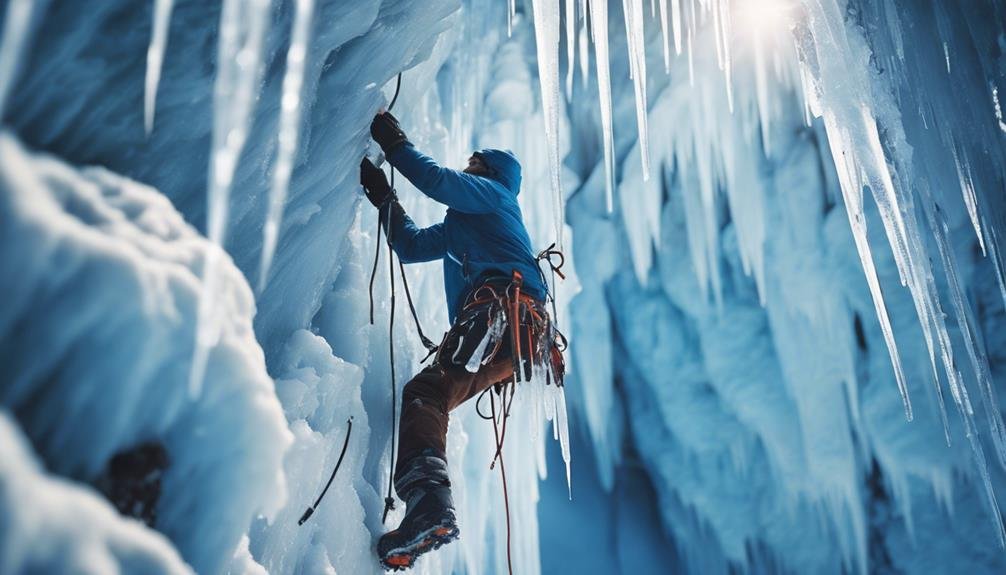
Ice climbing is an exhilarating sport where I ascend frozen waterfalls and icy rock faces, navigating a world transformed by winter's grip. At its core, ice climbing involves using specialized gear to scale vertical ice formations, which can range from delicate icicles to massive frozen cascades. The thrill of reaching the summit comes from the challenge of these ice climb definitions, where each ascent tests my strength, skill, and determination.
There are several types of ice formations I encounter, each presenting unique challenges. Frozen waterfalls are often the most striking, with their glistening surfaces and cascading beauty. I also tackle alpine ice, which forms on mountain faces, and mixed climbing, where I transition between ice and rock. Each type demands a different approach and technique, fueling my passion for this icy adventure.
The serenity of the winter landscape heightens the experience, as I find freedom in the crisp air and the crunch of ice beneath my crampons. Ice climbing isn't just about conquering heights; it's about embracing the wild beauty of winter, pushing my limits, and discovering a deeper connection to nature in its frozen form.
Essential Gear for Ice Climbers
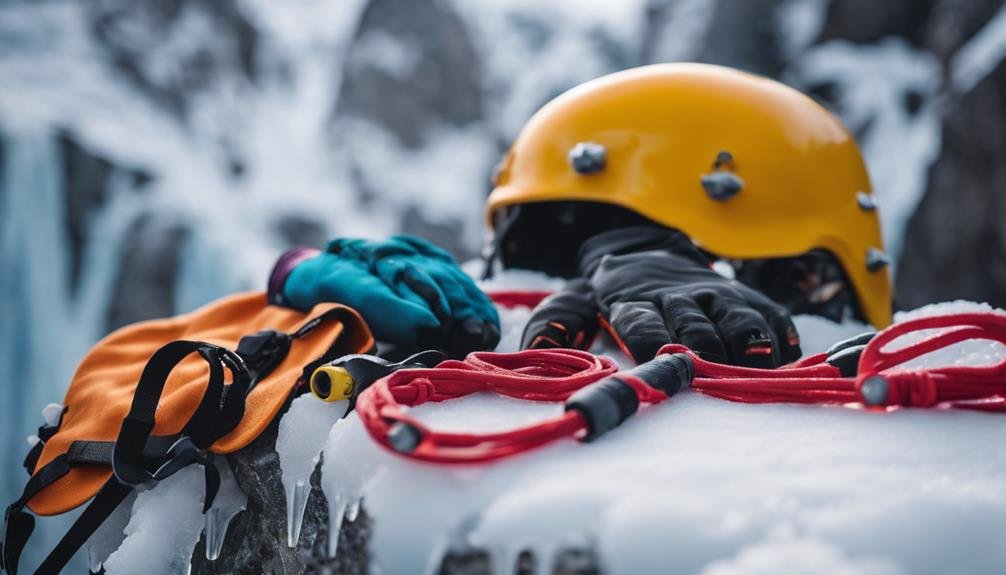
When I gear up for an ice climbing expedition, the right equipment can make all the difference between a thrilling adventure and a risky endeavor.
From must-have tools like crampons and ice axes to essential safety gear that keeps me secure on the ice, I've learned what I can't afford to leave behind.
Let's explore the vital gear that ensures I'm prepared for whatever challenges come my way.
Must-Have Equipment
Choosing the right gear is crucial for anyone looking to conquer frozen terrains and embrace the thrill of ice climbing. Crampons are your direct link to the ice, so choosing a pair that fits your boots snugly and suits the climbing conditions is essential. Whether you opt for the classic strap-on or the more modern automatic, make sure they're compatible with your footwear and provide the grip you need.
Equally vital is my ice ax. Regular maintenance can make a world of difference. I always check the sharpness of the pick and the condition of the adze before each climb. Keeping the pick sharp ensures a secure placement, while a well-maintained adze helps with cutting steps and anchoring.
Additionally, don't forget about a good climbing helmet and appropriate clothing to keep warm and dry. Layering is key; it allows you to adapt to changing temperatures as you scale those icy heights. With the right gear in hand, I feel unstoppable, ready to tackle whatever frozen challenge lies ahead.
Safety Gear Essentials
As I gear up for an ice climbing adventure, I never overlook the importance of safety essentials that keep me secure on those treacherous frozen surfaces. My first priority is my glove selection; I opt for a pair that balances warmth and dexterity. There's nothing worse than fumbling with gear in the biting cold, so I choose gloves that allow me to grip my tools without sacrificing protection.
Next, I make sure my crampon attachment is secure. With those sharp spikes digging into the ice, I feel a surge of confidence. I double-check the fit and straps, ensuring everything's snug and reliable. Trust me; a loose crampon can turn a thrilling ascent into a dangerous slip.
I also don't forget my helmet and harness—they're non-negotiable. The helmet protects my head from falling ice, while the harness keeps me tethered to the rope, offering an extra layer of security in case I lose my footing. By prioritizing these safety gear essentials, I can embrace the freedom of ice climbing, knowing I'm well protected as I conquer those icy heights.
Popular Ice Climbing Destinations

Nestled amid breathtaking landscapes, some of the world's most thrilling ice climbing destinations beckon adventurers eager to tackle frozen waterfalls and glacial walls. One of my favorite ideal ice climbing locales is Ouray, Colorado. The stunning ice park there's a playground for all skill levels, offering routes that range from beginner-friendly to exhilaratingly challenging.
Traveling internationally, I've found the frozen beauty of Chamonix, France, equally captivating. With its dramatic peaks and incredible ice formations, it's a must for any serious climber. The combination of stunning scenery and adrenaline-pumping climbs makes it a place I keep returning to.
If you're looking to expand your horizons, consider joining international ice climbing tours. They not only provide access to hidden gems like the ice-clad cliffs of Patagonia but also connect you with like-minded adventurers. Whether you're scaling frozen waterfalls in Iceland or tackling glacial ice in the Canadian Rockies, these experiences will enrich your climbing journey. Each destination offers its unique challenges and rewards, fueling my passion for this exhilarating sport.
Types of Ice Climbing Techniques
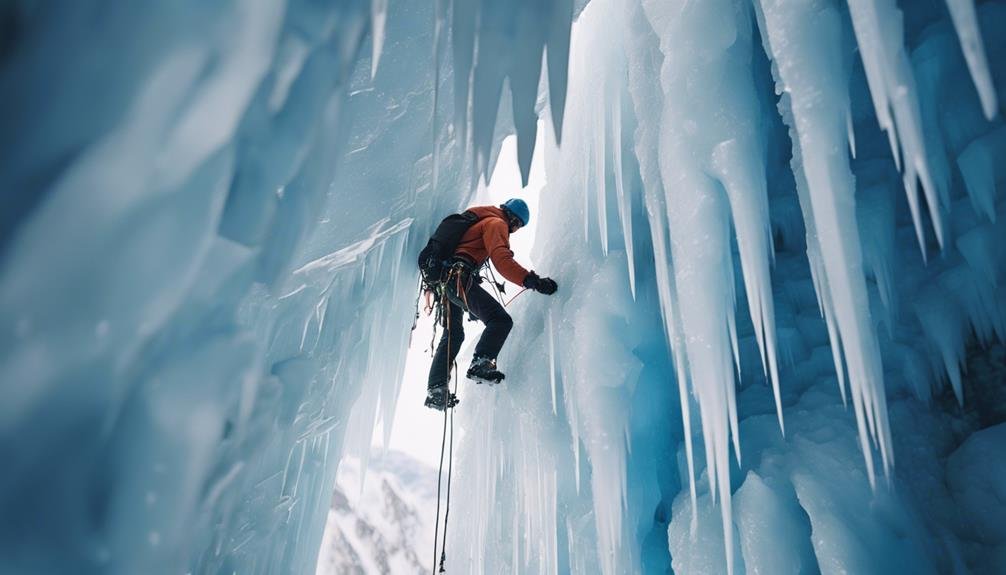
When I think about ice climbing techniques, I can't help but feel excited by the variety they offer.
From mastering the basics to tackling mixed climbing methods and exploring alpine ice approaches, each technique presents its own unique challenges and rewards.
Understanding these styles not only enhances my skills but also deepens my connection to the icy landscapes I love to conquer.
Basic Ice Climbing Techniques
Ice climbing combines strength, technique, and strategy, requiring climbers to master a variety of skills to navigate icy terrains safely and efficiently. As I've learned, understanding the basic ice climbing techniques can make all the difference in ensuring a successful ascent.
One key component is mastering ice anchoring techniques, which provide crucial safety measures. Properly placing ice screws and using natural features can secure your position. Additionally, lead climbing methods are essential for those who want to push their limits. These methods involve climbing ahead of your partner, placing protection as you ascend, allowing for a more dynamic progression.
Here's a quick overview of essential techniques:
| Technique | Description | Purpose |
|---|---|---|
| Ice Anchoring | Placing ice screws or using natural features | Provides safety and stability |
| Lead Climbing | Climbing ahead and placing protection | Increases efficiency and freedom |
| Movement Techniques | Utilizing tools and body position effectively | Enhances balance and control |
Mixed Climbing Methods
Mixed climbing methods blend rock and ice techniques, allowing climbers like me to tackle a diverse range of frozen and rocky terrains with confidence and adaptability. When I'm faced with mixed climbing challenges, I switch seamlessly between using my ice tools on frozen sections and my rock shoes on the dry rock. This dynamic approach keeps the adrenaline pumping and demands not just physical strength but also mental agility.
In my mixed climbing experiences, I've discovered the thrill of finding the perfect foothold or handhold on a rugged crag, knowing I might pivot to an ice section just a few feet away. Each route becomes a puzzle, requiring me to assess the best gear and technique for the conditions.
I relish the variety; one moment I'm striking into a frozen waterfall, and the next, I'm navigating a steep rock face. Embracing mixed climbing has opened up a world of possibilities, where every ascent is an exhilarating journey. It's a blend of skills and instincts that pushes me not just to climb, but to explore the very essence of adventure.
Alpine Ice Approaches
Navigating the icy slopes of alpine routes requires mastering a variety of techniques, each tailored to the unique challenges presented by different types of ice and terrain. I've found that understanding these technical climbing approaches not only boosts my confidence but also enhances my overall experience in the frozen wilderness.
Here's a quick overview of essential techniques I often rely on:
| Technique | Description | Ideal Conditions |
|---|---|---|
| Front Pointing | Using the front points of crampons for grip | Steep, hard ice |
| Ice Screw Placement | Properly placing screws for protection | Mixed ice and rock sections |
| Hooking | Utilizing the tools to hook onto features | Fragile or thin ice layers |
Each technique serves a distinct purpose, guiding me through the icy labyrinth with precision and grace. Whether I'm scaling a steep face or navigating a technical section, these methods empower me to embrace the challenge, each movement echoing my desire for freedom in the heart of the mountains. It's all about finding that rhythm and flow, allowing me to connect with the ice in ways that words can't fully capture.
Safety Tips for Beginners
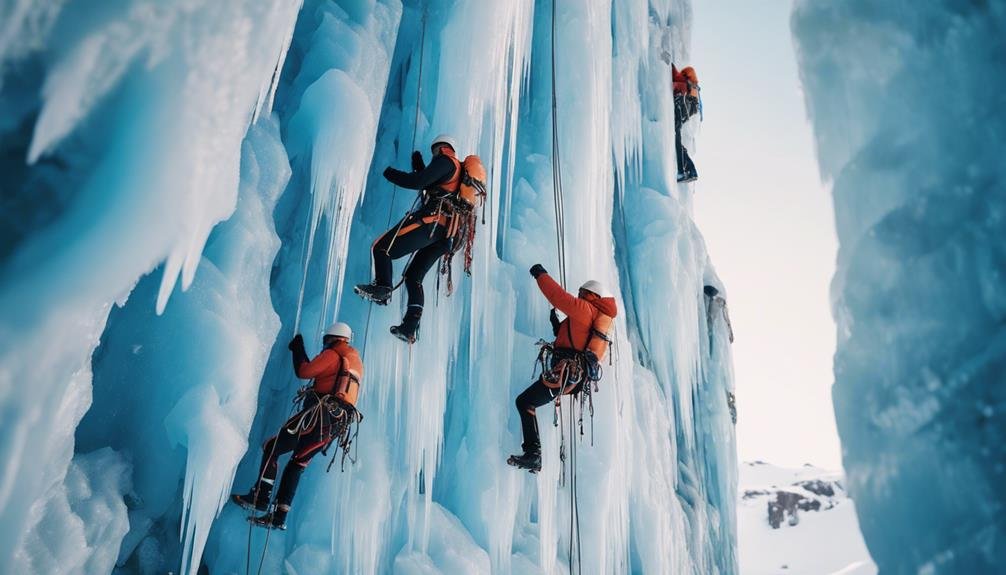
Before I strap on my crampons and grab my ice tools, I always make sure to review essential safety tips to ensure a secure and enjoyable climbing experience.
First off, proper clothing choice is crucial. I opt for moisture-wicking layers that keep me warm without overheating. A waterproof outer layer is a must to shield me from the biting wind and falling ice.
Next, I focus on technique progression. As a beginner, I avoid rushing into complex climbs. Instead, I practice my footwork and tool placements on more manageable routes, allowing me to build confidence and skills gradually. I always double-check my gear before each climb, ensuring everything's in top condition.
Another tip? Stay aware of your surroundings. Ice conditions can change rapidly, so I keep an eye on the weather and listen for any signs of instability. Also, I make sure to climb with a partner, as having someone by my side enhances safety and provides support.
Physical Fitness for Ice Climbing

To tackle ice climbing, I've learned that physical fitness is crucial for success and safety.
Building strength, endurance, and flexibility not only enhances my performance but also helps prevent injuries on the ice.
With the right training, I feel more confident and ready to conquer those frozen walls.
Strength Training Essentials
Building strength in key muscle groups is crucial for anyone looking to conquer the challenges of ice climbing. I've found that targeting my upper body, core, and legs makes a significant difference in my performance. Muscular endurance is essential; it allows me to maintain my grip and power through tough sections without burning out. Core development, on the other hand, stabilizes my movements and keeps me balanced on unpredictable surfaces.
To illustrate the essential exercises, here's a quick reference table:
| Muscle Group | Key Exercises |
|---|---|
| Upper Body | Pull-ups, Shoulder Press |
| Core | Planks, Russian Twists |
| Legs | Squats, Lunges |
Incorporating these exercises into my routine not only boosts my strength but also enhances my confidence on the ice. I can feel the difference when I'm hanging on to my tools, knowing my body is up for the challenge. The freedom to climb higher, tackle steeper walls, and explore the frozen wilderness is what drives me, and strength training is the passport to that adventure.
Endurance and Stamina
Mastering endurance and stamina is vital for tackling the grueling demands of ice climbing, as it enables me to push through long ascents and maintain my focus while navigating treacherous terrain. Each climb tests not just my physical strength, but my ability to endure, to keep moving even when my muscles scream for relief.
I've found that incorporating cardio training into my routine is essential. Whether it's running, cycling, or rowing, each session builds my aerobic capacity, ensuring I can tackle those steep ice walls without gasping for air.
Endurance building doesn't stop there; I also mix in interval training, which mimics the bursts of energy I need during a climb. I sprint up hills, pushing my limits, and then recover, preparing my body for the unpredictable challenges ahead.
The thrill of reaching a summit, with the wind in my face and the world spread below, makes every bead of sweat worth it. I've learned that when I invest in my endurance, I'm not just preparing for the climb; I'm embracing the freedom that comes with conquering nature's frozen playground.
Flexibility and Mobility
Emphasizing flexibility and mobility has become essential in my ice climbing training, as it allows me to maneuver gracefully over steep, uneven surfaces while reducing the risk of injury. I've discovered that incorporating dynamic stretches and yoga into my routine dramatically enhances my joint mobility. This newfound range of motion not only helps me reach those tricky holds but also keeps my body balanced and agile when I'm hanging off ice formations.
Core strengthening exercises are equally important. A strong core stabilizes my body, enabling me to shift my weight fluidly and maintain control, especially when I'm navigating challenging routes. When I engage in planks or leg raises, I can feel my body preparing for the demands of climbing, making those strenuous ascents feel more manageable.
Incorporating these elements into my training has transformed my climbing experience, allowing me to embrace the freedom of movement that ice climbing offers. With improved flexibility and mobility, I'm not just climbing; I'm dancing with the ice, moving fluidly and confidently, ready to conquer the next frozen challenge that awaits.
Ice Climbing Training and Skills

To excel in ice climbing, one must develop a diverse set of skills that blend physical strength, mental resilience, and technical knowledge. I've discovered that a solid training routine is essential. My ice climbing training routines focus on building core strength and endurance, incorporating exercises like pull-ups, core workouts, and leg presses. I also mix in cardio to boost my stamina, ensuring I can tackle those challenging ascents.
Skill progression strategies play a crucial role in my journey. I start with the basics—learning to use my ice axes and crampons effectively. Gradually, I tackle more complex routes, practicing techniques like footwork and body positioning. I never underestimate the importance of mental toughness; visualization and breath control help me stay calm and focused when I'm hanging by a thread of ice.
Every climb is a new adventure, and I embrace the thrill of pushing my limits. By honing my skills and refining my training, I find freedom in the icy landscapes, ready to conquer whatever challenge lies ahead. Ice climbing isn't just a sport; it's a lifestyle that demands dedication and passion.
Environmental Considerations
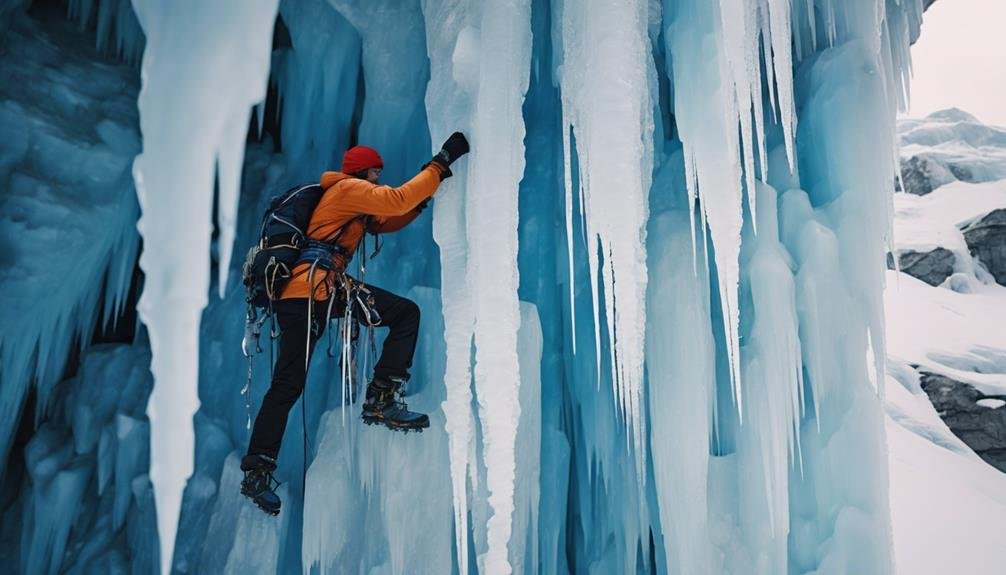
Considering the delicate ecosystems that thrive in icy terrains, I always strive to minimize my impact while ice climbing. Each time I lace up my boots and grab my gear, I remember that these breathtaking landscapes don't just exist for our thrill; they're home to diverse flora and fauna.
By adopting sustainable practices, I ensure that my passion doesn't come at the expense of nature. I make it a point to stick to established trails and climbing routes. This not only conserves the fragile ground cover but also protects the habitats of creatures that call these icy realms home.
I also pack out what I pack in, ensuring I leave no trace of my adventure. This aligns with my belief in environmental ethics—respecting and preserving our planet for future climbers and explorers.
When I climb, I often stop to appreciate the stunning beauty around me, reminding myself that my freedom in these wild spaces comes with responsibility. By embracing sustainable practices, I can enjoy my frozen adventures while safeguarding the very environments that fuel my passion for ice climbing.
Together, we can respect these majestic landscapes and ensure they endure for generations to come.
The Thrill of Ice Climbing
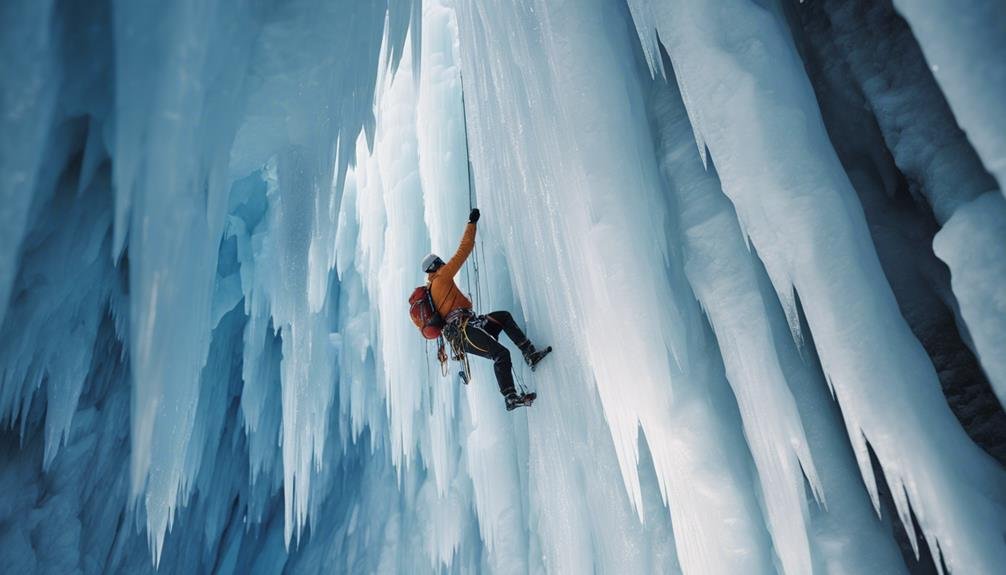
After ensuring I leave no trace on the pristine icy landscapes, the rush of scaling frozen waterfalls and towering ice formations fills me with an exhilarating sense of adventure that few experiences can match. Each swing of my ice axe sends a jolt of adrenaline coursing through my veins, igniting a fire within me. I can feel the chill in the air, but it's nothing compared to the warmth of excitement I feel as I ascend.
Ice climbing isn't just about reaching the top; it's about embracing the challenge of mastery. As I navigate the intricate contours of the ice, I learn to trust my instincts and adapt to the ever-changing conditions. Every climb pushes me to confront my fears, testing my physical strength and mental resolve.
The thrill lies in the journey, each ascent a dance between determination and the raw beauty of nature. With every successful climb, I gain confidence and experience, reminding me that freedom often comes with a touch of risk. In those moments, suspended between the earth and sky, I find my true self, craving more of this frozen adventure.
Joining an Ice Climbing Community
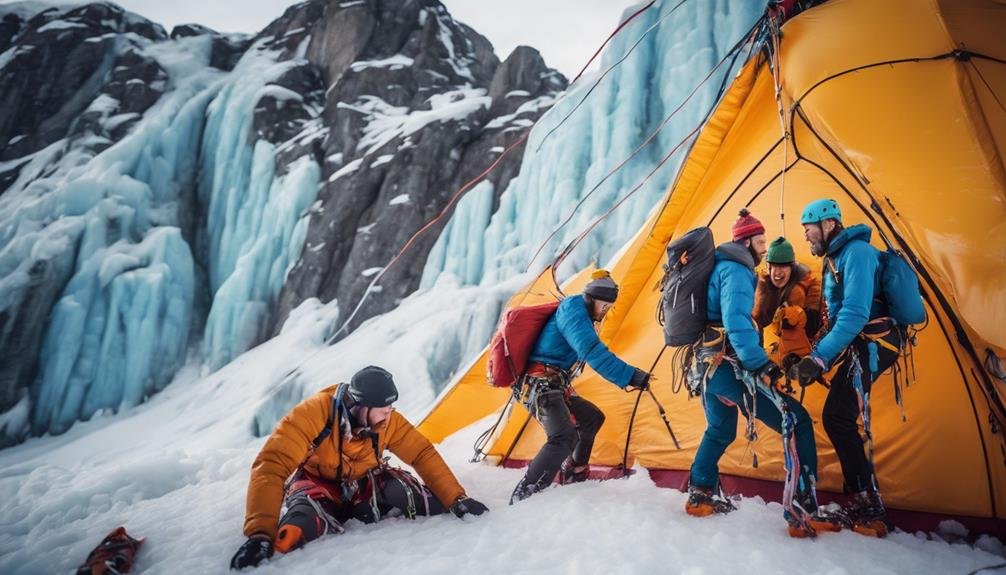
Immersing myself in an ice climbing community transforms the solitary pursuit into a vibrant tapestry of shared experiences and camaraderie. When I first joined, I was immediately struck by the infectious energy of fellow climbers, each one passionate about conquering frozen waterfalls and icy cliffs. This wasn't just about climbing; it was about community building. We swapped tips on technique, shared stories of our scariest ascents, and celebrated each other's triumphs, big and small.
Fostering camaraderie became second nature. We organized weekend trips, turning daunting climbs into exhilarating adventures filled with laughter, hot cocoa, and the thrill of the challenge. I found mentors who pushed me to improve and peers who cheered me on, creating an environment where I felt safe to test my limits.
As I climbed alongside these amazing individuals, I realized that the bonds we formed were as strong as the ice beneath our crampons. Together, we explored new terrains, shared gear, and even tackled our fears. The community enriched my ice climbing experience, reminding me that this frozen adventure is best enjoyed together.
Conclusion
Ice climbing's not just a sport; it's a thrilling dance with nature's frozen giants. Each ascent feels like I'm conquering a magnificent ice sculpture, every swing of my axe echoing my determination.
I've learned to embrace the challenges, from mastering techniques to understanding the ice's temperament. As I navigate these icy realms, I find not only adventure but a community of fellow enthusiasts who share this passion.
So, if you're brave enough, grab your gear and join the climb!
